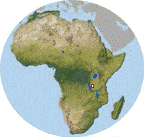

The following is summarised from Kano, T. (1972). Distribution and adaptation of the chimpanzee on the eastern shore of Lake Tanganyika. Kyoto Univ. Afr. Stud. 7: 37-129.
Ugalla has the least forest in the whole distribution area of the Tanzania chimpanzee. It comprises 91.3% Woodland, 42.7% of which is Julbernardia globiflora and 23.2% which is Brachystegia boehmii. Chimpanzees in the area utilize Brachystegia bussei and Landolphia spp. ("Katimba") for their staple foods.
In this region, the Ugalla, Malagarasi and Lugufu Rivers appear to act as boundaries to chimpanzee expansion. No chimps have been found on eastern side of the Ugalla River. One possible explanation is that there are no riverine forests located on this side of the Ugalla.
(Directly from Kano, 1972): The Ugalla area consists of a broken table-like plateau, connecting the Masito Hills on the west. The Ugalla Hills are higher in the southwestern part (more than 1,500 meters above sea-level, Fig. 8) and lower in the north-northeastern parts (less than 1,200 meters). The rivers flowing to the Malagarasi and to the Ugalla, which constitute the northern and eastern boundaries, are long and those pouring into the Niamanzi and the Lugufu in the south are short.
The main streams (Issa, Mogogwesi, etc.) in this area run through steep escarpments forming deep canyons with flat bottoms which are often several hundred meters wide. There are few narrow and steep valleys such as are often seen in the Masito Area. There is almost no incline in these wide canyons running about some 10 kilimeters to the Malagarasi or to the Ugalla. When the rain stops, most of those streams run dry, while they get marshy during the wet season. There is a long escarpment which runs from the Kisegwa Mountain, situated at the southeastern part of the area to the Nkondwe village at the southernmost part, where the Ugalla Hills connect with the northeastern slope of the Makomayo Mountains. In general, the chimpanzees do not cross over this escarpment to the Niamanzi basin, though the native information indicates that vagrant chimpanzees sometimes visit the Mnyangwa Mountain, an isolated peak in the northern part of the basin.
[end Kano material]
There has yet to be a continuous study of the chimpanzees at Ugalla. I have been several times, most recently in 1993; several other investigators have visited as well in the last few years (Gen'ichi Idani, Adriana Hernandez, Hideshi Ogawa, Travis Pickering, Jeanne Sept, Janette Wallis). As of 2009, 1 dissertation has been completed (Hernandez) and 3 are in progress (Alex Piel, UCSD; Fiona Stewart, Cambridge; Deborah Moore, UT San Antonio). See the website of the Ugalla Primate Project for more details.
It is worth emphasizing that Kano (1972) and I (1992) came up with nearly identical density estimates based on nest transects, suggesting that the population has remained stable for at least 20 years during which time selective logging and traditional use of forest products has continued. As long as human pressure on the area does not increase over 1980s-levels, there is every reason to believe this joint use by apes and humans can continue indefinitely.
Primary source for the following Site Data is McGrew et. al. (1996), Great Ape Societies (Cambridge University Press), Appendix.
| Location: | Kigoma-Mpanda Districts, Tanzania. Main (temporary) camp at 5° 19' S, 30° 37' E). The research area does not conform to any political or geographic boundaries; the primatological site name "Ugalla" comes from the nearby Ugalla River but locally, "Ugalla" typically refers to the Ugalla Game Controlled Area, east of the Ugalla River (no chimpanzees confirmed), and the research area is to the west of the river. |
| Status: | Forest Reserve (part), part unprotected |
| Area: | ca. 2800 km2; boundaries undefined - most work in a plateau region bounded by the Uvinza-Mpanda Road (W), Malagarasi River (N), Ugalla River (E), and dropoff to lower elevation to the south. |
| Altitude: |
1100-1600m 900-1800m |
| Temperature: | --- |
| Rainfall (8K): | 1012mm/yr, range 745-1280 (1973-1988) [Uvinza weather station] |
| Vegetation: | Grassy woodland, Brachystegia - Julbernardia miombo woodland. A species list is available at http://www.primate.wisc.edu/pin/tro1.html |
| Human Influence: |
Selective logging, honey collecting, some hunting (local and professional safari), some foot traffic Disturbance ratings -- 3, 2, 1, 2, 1 |
| Closest village: | 5-10 km |
| Species studied: | Pan troglodytes schweinfurthii |
| Population Density |
0.08 per km2 0.08-0.122 |
| Fauna (9K): | Mammals, birds, reptiles, etc..... |
| Study Period: | 1985, 1988, 1992, 1993, 1998, 2001 - ongoing |
| Habituation: | None |
| Research Presence: | Occasional during 1990s, semi-continuous since 2001 |
| Conservation: | Informal and minimal to date, e.g. subscriptions and books to local schools |
| Current Research: | Feeding ecology, nest distribution, sustainable forest use, range use, community structure via DNA |
| Methods: | Indirect evidence |
| Contact Person: |
Jim Moore, Department of Anthropology, University of California San Diego, La Jolla, CA 92093, USA [jjmoore@ucsd.edu] Hideshi Ogawa, Primate Research Institute, Kyoto University, Inuyama, Aichi 484, Japan [hogawa@lets.chukyo-u.ac.jp] |
| Habitat Photos: | Photos of the area, vegetation, and overall habitat |
| Maps: | Topographic maps, survey areas |
| Aerial Photos: | Oblique and vertical mapping photos of the Ugalla area |
| Bibliography: | Publications related to the site (see also Kasakati and Filabanga, under Mahale, for ecologically similar sites). |
| |
| Miscellaneous | Other related |